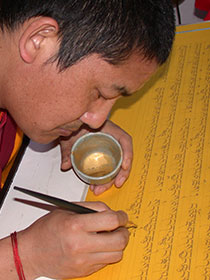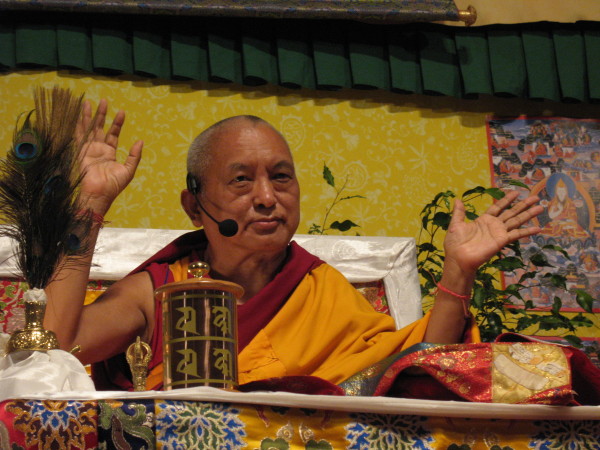- Home
- FPMT Homepage
Foundation for the Preservation of the Mahayana Tradition
The FPMT is an organization devoted to preserving and spreading Mahayana Buddhism worldwide by creating opportunities to listen, reflect, meditate, practice and actualize the unmistaken teachings of the Buddha and based on that experience spreading the Dharma to sentient beings. We provide integrated education through which people’s minds and hearts can be transformed into their highest potential for the benefit of others, inspired by an attitude of universal responsibility and service. We are committed to creating harmonious environments and helping all beings develop their full potential of infinite wisdom and compassion. Our organization is based on the Buddhist tradition of Lama Tsongkhapa of Tibet as taught to us by our founders Lama Thubten Yeshe and Lama Thubten Zopa Rinpoche.
- Willkommen
Die Stiftung zur Erhaltung der Mahayana Tradition (FPMT) ist eine Organisation, die sich weltweit für die Erhaltung und Verbreitung des Mahayana-Buddhismus einsetzt, indem sie Möglichkeiten schafft, den makellosen Lehren des Buddha zuzuhören, über sie zur reflektieren und zu meditieren und auf der Grundlage dieser Erfahrung das Dharma unter den Lebewesen zu verbreiten.
Wir bieten integrierte Schulungswege an, durch denen der Geist und das Herz der Menschen in ihr höchstes Potential verwandelt werden zum Wohl der anderen – inspiriert durch eine Haltung der universellen Verantwortung und dem Wunsch zu dienen. Wir haben uns verpflichtet, harmonische Umgebungen zu schaffen und allen Wesen zu helfen, ihr volles Potenzial unendlicher Weisheit und grenzenlosen Mitgefühls zu verwirklichen.
Unsere Organisation basiert auf der buddhistischen Tradition von Lama Tsongkhapa von Tibet, so wie sie uns von unseren Gründern Lama Thubten Yeshe und Lama Thubten Zopa Rinpoche gelehrt wird.
- Bienvenidos
La Fundación para la preservación de la tradición Mahayana (FPMT) es una organización que se dedica a preservar y difundir el budismo Mahayana en todo el mundo, creando oportunidades para escuchar, reflexionar, meditar, practicar y actualizar las enseñanzas inconfundibles de Buda y en base a esa experiencia difundir el Dharma a los seres.
Proporcionamos una educación integrada a través de la cual las mentes y los corazones de las personas se pueden transformar en su mayor potencial para el beneficio de los demás, inspirados por una actitud de responsabilidad y servicio universales. Estamos comprometidos a crear ambientes armoniosos y ayudar a todos los seres a desarrollar todo su potencial de infinita sabiduría y compasión.
Nuestra organización se basa en la tradición budista de Lama Tsongkhapa del Tíbet como nos lo enseñaron nuestros fundadores Lama Thubten Yeshe y Lama Zopa Rinpoche.
A continuación puede ver una lista de los centros y sus páginas web en su lengua preferida.
- Bienvenue
L’organisation de la FPMT a pour vocation la préservation et la diffusion du bouddhisme du mahayana dans le monde entier. Elle offre l’opportunité d’écouter, de réfléchir, de méditer, de pratiquer et de réaliser les enseignements excellents du Bouddha, pour ensuite transmettre le Dharma à tous les êtres. Nous proposons une formation intégrée grâce à laquelle le cœur et l’esprit de chacun peuvent accomplir leur potentiel le plus élevé pour le bien d’autrui, inspirés par le sens du service et une responsabilité universelle. Nous nous engageons à créer un environnement harmonieux et à aider tous les êtres à épanouir leur potentiel illimité de compassion et de sagesse. Notre organisation s’appuie sur la tradition guéloukpa de Lama Tsongkhapa du Tibet, telle qu’elle a été enseignée par nos fondateurs Lama Thoubtèn Yéshé et Lama Zopa Rinpoché.
Visitez le site de notre Editions Mahayana pour les traductions, conseils et nouvelles du Bureau international en français.
Voici une liste de centres et de leurs sites dans votre langue préférée
- Benvenuto
L’FPMT è un organizzazione il cui scopo è preservare e diffondere il Buddhismo Mahayana nel mondo, creando occasioni di ascolto, riflessione, meditazione e pratica dei perfetti insegnamenti del Buddha, al fine di attualizzare e diffondere il Dharma fra tutti gli esseri senzienti.
Offriamo un’educazione integrata, che può trasformare la mente e i cuori delle persone nel loro massimo potenziale, per il beneficio di tutti gli esseri, ispirati da un’attitudine di responsabilità universale e di servizio.
Il nostro obiettivo è quello di creare contesti armoniosi e aiutare tutti gli esseri a sviluppare in modo completo le proprie potenzialità di infinita saggezza e compassione.
La nostra organizzazione si basa sulla tradizione buddhista di Lama Tsongkhapa del Tibet, così come ci è stata insegnata dai nostri fondatori Lama Thubten Yeshe e Lama Zopa Rinpoche.
Di seguito potete trovare un elenco dei centri e dei loro siti nella lingua da voi prescelta.
- 欢迎 / 歡迎
简体中文
“护持大乘法脉基金会”( 英文简称:FPMT。全名:Foundation for the Preservation of the Mahayana Tradition) 是一个致力于护持和弘扬大乘佛法的国际佛教组织。我们提供听闻,思维,禅修,修行和实证佛陀无误教法的机会,以便让一切众生都能够享受佛法的指引和滋润。
我们全力创造和谐融洽的环境, 为人们提供解行并重的完整佛法教育,以便启发内在的环宇悲心及责任心,并开发内心所蕴藏的巨大潜能 — 无限的智慧与悲心 — 以便利益和服务一切有情。
FPMT的创办人是图腾耶喜喇嘛和喇嘛梭巴仁波切。我们所修习的是由两位上师所教导的,西藏喀巴大师的佛法传承。
繁體中文
護持大乘法脈基金會”( 英文簡稱:FPMT。全名:Found
ation for the Preservation of the Mahayana Tradition ) 是一個致力於護持和弘揚大乘佛法的國際佛教組織。我們提供聽聞, 思維,禪修,修行和實證佛陀無誤教法的機會,以便讓一切眾生都能 夠享受佛法的指引和滋潤。 我們全力創造和諧融洽的環境,
為人們提供解行並重的完整佛法教育,以便啟發內在的環宇悲心及責 任心,並開發內心所蘊藏的巨大潛能 — 無限的智慧與悲心 – – 以便利益和服務一切有情。 FPMT的創辦人是圖騰耶喜喇嘛和喇嘛梭巴仁波切。
我們所修習的是由兩位上師所教導的,西藏喀巴大師的佛法傳承。 察看道场信息:
- FPMT Homepage
- News/Media
-
- Study & Practice
-
-
- About FPMT Education Services
- Latest News
- Programs
- New to Buddhism?
- Buddhist Mind Science: Activating Your Potential
- Heart Advice for Death and Dying
- Discovering Buddhism
- Living in the Path
- Exploring Buddhism
- FPMT Basic Program
- FPMT Masters Program
- FPMT In-Depth Meditation Training
- Maitripa College
- Lotsawa Rinchen Zangpo Translator Program
- Universal Education for Compassion & Wisdom
- Online Learning Center
-
- Prayers & Practice Materials
- Overview of Prayers & Practices
- Full Catalogue of Prayers & Practice Materials
- Explore Popular Topics
- Benefiting Animals
- Chenrezig Resources
- Death & Dying Resources
- Lama Chopa (Guru Puja)
- Lama Zopa Rinpoche: Compendium of Precious Instructions
- Lama Zopa Rinpoche: Life Practice Advice
- Lama Zopa Rinpoche Practice Series
- Lamrim Resources
- Mantras
- Prayer Book Updates
- Purification Practices
- Sutras
- Thought Transformation (Lojong)
- Audio Materials
- Dharma Dates - Tibetan Calendar
- Translation Services
- Publishing Services
- Ways to Offer Support
- Prayers & Practice Materials
-
- Teachings and Advice
- Find Teachings and Advice
- Lama Zopa Rinpoche Advice Page
- Lama Zopa Rinpoche: Compendium of Precious Instructions
- Lama Zopa Rinpoche Video Teachings
- ༧སྐྱབས་རྗེ་བཟོད་པ་རིན་པོ་ཆེ་མཆོག་ནས་སྩལ་བའི་བཀའ་སློབ་བརྙན་འཕྲིན།
- Podcasts
- Lama Yeshe Wisdom Archive
- Buddhism FAQ
- Dharma for Young People
- Resources on Holy Objects
- Teachings and Advice
-
-
*If a menu item has a submenu clicking once will expand the menu clicking twice will open the page.
-
-
- Centers
-
- Teachers
-
- Projects
-
-
-
-
*If a menu item has a submenu clicking once will expand the menu clicking twice will open the page.
-
-
- FPMT
-
-
-
-
-
However the very bottom line is to do all ones actions with bodhichitta. That is the best, the most meaningful way to think during your break time. This makes your life most beneficial. As much as possible with awareness keep ones attitude and thoughts in bodhichitta, the thought of benefiting others, try to do all the activities with that mind, including doing your job and throughout the day. This way even in your break time whatever you do becomes the cause of happiness.
Lama Zopa Rinpoche
-
-
-
- Shop
-
-
-
The Foundation Store is FPMT’s online shop and features a vast selection of Buddhist study and practice materials written or recommended by our lineage gurus. These items include homestudy programs, prayers and practices in PDF or eBook format, materials for children, and other resources to support practitioners.
Items displayed in the shop are made available for Dharma practice and educational purposes, and never for the purpose of profiting from their sale. Please read FPMT Foundation Store Policy Regarding Dharma Items for more information.
-
-
Mandala
25
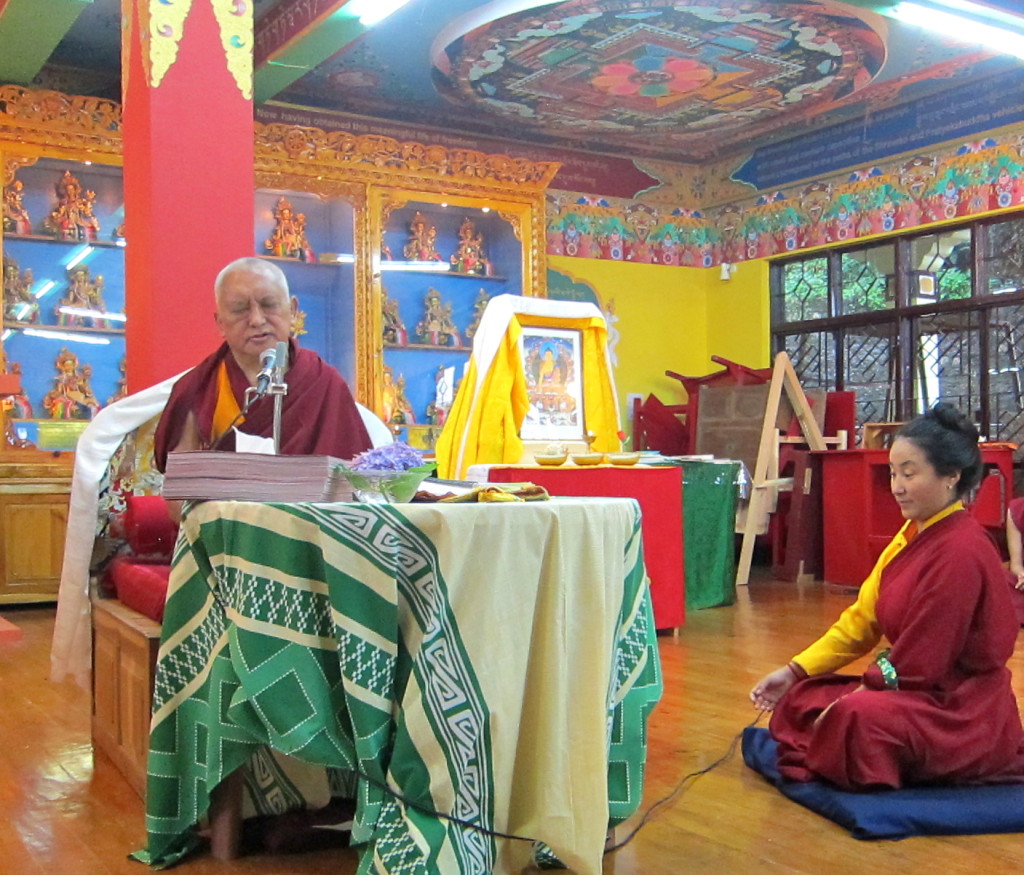
Lama Zopa Rinpoche during teaching on guru devotion with Khadro-la, Tushita Meditation Centre, India, June 2013. Photo by Ven. Sarah Thresher.
Ven. Sarah Thresher shared this report from Tushita Meditation Centre in Dharamsala, India:
On June 14, FPMT spiritual director Lama Zopa Rinpoche invited Rangjung Neljorma Khadro Namsel Drönme [Khadro-la] to attend the picnic at the end of a dual course at Tushita. There were over 100 people present.
Rinpoche made a special point of thanking the cooks and kitchen staff who produce delicious meals three times a day without using onions or garlic. Tushita has put special effort into making the food served on the courses excellent. Rinpoche commented that sometimes when the course subjects are difficult for the new students having good food helps them to digest it all more easily!
Tushita runs year-round a 10-day introductory courses (which is very reasonably priced) and people travel from around the world to attend and take advantage of this special environment. For years the courses have been overbooked. Last course they turned away 40 people!
Rinpoche also thanked Tushita’s spiritual program coordinator, teachers and meditation leaders. Khadro-la was requested to give a talk and Geshe Kelsang Wangmo from the Institute of Buddhist Dialectics translated.
Then Rinpoche gave a three-hour teaching on guru devotion for the new people with quotes and transmission of “Calling the Guru from Afar.” For this 10-day introductory course, Rinpoche taught seven days running and gave the oral transmission of the Vajra Cutter Sutra as well as a new morning meditation practice that he put together and translated to help make people’s lives meaningful. (more…)
- Tagged: khandro kunga bhuma, lama zopa rinpoche, mandala, tushita meditation centre, ven. sarah thresher
- 0
24
Over the years, Mandala has explored the issue of vegetarianism and the question of whether or not to eat meat. But with a growing awareness of issues of animal cruelty and environmental concerns connected to the production of dairy products and eggs, many FPMT students have taken up the practice of veganism, including Nicholas Ribush, director of the Lama Yeshe Wisdom Archive. In this issue’s online edition, Nick explains his motivations for his decision in “On Becoming a Vegan.”
At the 2009 CPMT meeting in France, Nick asked Rinpoche about veganism, to which Rinpoche gives an expansive and motivational response.
Nick Ribush: Rinpoche, how do you feel about FPMT promoting a policy of not only vegetarianism, but also veganism, because of the cruelty to animals inherent in the production of dairy products and so forth?
Lama Zopa Rinpoche: The reality is that we cannot live without harming others. There’s no way we can survive without others being harmed, killed. We can’t survive for even a day without causing suffering to others.
This is how life is in samsara and that’s why the ultimate answer is to get out of samsara, to be liberated from it. Only when you free yourself from samsara by actualizing the remedy, the true path, the wisdom directly perceiving emptiness, which directly terminates the delusions, the disturbing thought obscurations, and the negative imprints, the seeds of delusion, will you no longer have to reincarnate, no longer have to go through the cycle of death and rebirth, experiencing all the sufferings of the six realms, one after the other.
It’s only when you’re liberated from samsara that others don’t have to suffer for your happiness, only then that others don’t have to be harmed or killed in order for you to survive. Therefore, actualizing the path is of the utmost urgency; that’s the emergency …
Read the full teaching as part of Mandala‘s July-September 2013 online content …
- Tagged: mandala, teachings and advice
- 0
20
New Photo Gallery: Lama Zopa Rinpoche Tours Taiwan, Singapore, Malaysia and Hong Kong
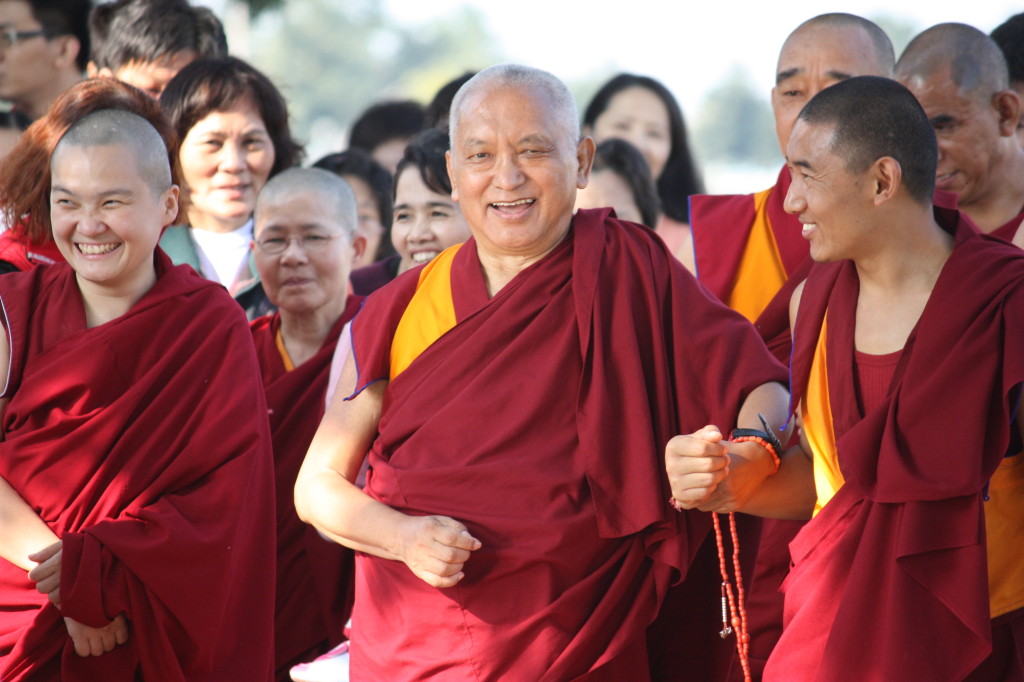
Lama Zopa Rinpoche with FPMT Taiwan resident geshes, Sangha and students on Losar, Taichung, Taiwan, February 11, 2013. Photo by Ven. Thubten Kunsang.
Mandala’s new issue features FPMT spiritual director Lama Zopa Rinpoche’s tour of FPMT centers in Taiwan, Singapore, Malaysia and Hong Kong during February-March 2013. For our online edition, we’ve collected some of our favorite photos from the tour, which you can see in an online photo gallery.
If you’d like to receive a print copy of the new issue, consider becoming a Friend of FPMT at the Basic level. Sign up this month and we will send you the new issue as well as a link to an electronic version that you can read right away online; or order the new issue from the Foundation Store.
We also welcome bulk orders and offer special prices for Mandala for FPMT centers. For more information on how to get Mandala to more members at your center, contact us.
18
New Online Edition of Mandala LIVE
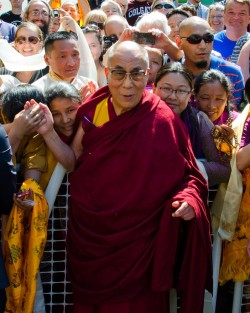
His Holiness the Dalai Lama outside of Maitripa College, Portland, Oregon, U.S., May 10, 2013. Photo by Marc Sakamoto.
The new print issue of Mandala is in the mail and our new online edition is live!
Here are some highlights from this issue’s online content:
- New photos of His Holiness the Dalai Lama’s travels, including to Maitripa College’s Dalai Lama Environmental Summit and FPMT International Office in Portland, Oregon, U.S.
- Photos of Lama Zopa Rinpoche’s tour of Taiwan, Singapore, Malaysia and Hong Kong
- An interview with Canadian scientist David Suzuki on His Holiness and the environment
- And much, much more …
To receive the print edition of Mandala, featuring coverage of Lama Zopa Rinpoche’s Asia Tour and His Holiness’ visit to Maitripa College and FPMT International Office, become a Friend of FPMT by the end of June. We’ll send you the new issue right away as well as a link to an electronic version.
To keep up with all of the new stories from Mandala, including our “FPMT News Around the World” blog and Ven. Roger Kunsang’s “Life on the Road with Lama Zopa Rinpoche,” subscribe to our RSS feed, which will send new posts directly to your email inbox.
17
‘Your Dog Smells’
By Ven. Chönyi Taylor
“Your dog smells,” says my granddaughter. “He smells even after you wash him.”
“Well, that’s true, but you smell too.”
“No, I don’t.”
“Of course you do. Everyone has their own smell.”
“Well, my smell is not a BAD smell.”
“That all depends. Your smell may be nice to you, but my dog might not like it. He probably wishes you’d go and roll in some wombat poo.”
“Eeyyooouu. No way.”
“I don’t particularly like that deodorant you use, anyway, but obviously you like it.”
“So?”
“So can Merlin have his own smell?”
No reply. She is an intelligent girl and gets the thrust of my argument.
It all depends. What smells good to a dog does not smell good to us, and I expect vice versa. If my dog could talk, he would probably agree that one smell is wombat poo and the other smell some flowery deodorant. But there would be big differences in what we might perceive as good or bad.
We may agree that the object on my rug is a smelly dog, but whether the smell or the dog is seen to be good or bad is entirely our own preference. What matters is that having made that preference, a whole lot of implications follow. If we label “bad” then we develop an aversion. If we label “good” then we develop an attraction. Now, having developed an aversion, then other thoughts fall quickly in line:
I don’t like that smell, therefore, I don’t want that dog here; therefore, I want you to send him out, which you won’t; therefore, I have an aversion to you; therefore, I am not going to listen to you. This will make you angry with me, which confirms that I ought to have an aversion to you; which means I will now only see your negative side; which means that though you were once my friend, now you are my enemy; which means that I am alone in this world; which is unfair; which means I feel really sorry for myself …
Smells are interesting things. My dog’s perception of smell is way more sophisticated than mine. It has a richness that we experience through our eyes. Our color sense has countless subtle shades not available to him and he has countless tiny variations in smell not available to us. He constructs his world through smells.
I sometimes wonder what it would be like to negotiate the world by smell instead of sight. Would we identify things by their particular hues of smell? What would happen to our perception of boundaries? Our eye sense easily picks up boundaries and makes things stand out from each other. Smells do not have boundaries; they simply become more and more diluted. Would we lose that sense of separation from things as their smells intertwine as they waft past? Would we sense ourselves as a cloud trailing behind us or blowing in the wind? Would we then view the world as a swirling smellscape in which different smells may sometimes predominate? Would we be immediately aware of how we affect each other as our individual smells drift together like smoke from burning incense? What would happen if we constructed our world mainly through smell?
Imagine that you are blind and deaf, but have an acute sense of smell. What would you recognize in your environment? Would you know when I entered your room? What would you be aware of when traveling on a train or bus? How rich, or poor, would your world become? Until we stop and contemplate like this, we have no idea how strongly our senses affect the way in which we see – or smell – the world.
If things are no longer predominantly rigid, with sharp boundaries, then there is a chance that our minds will not be rigid with sharp boundaries. In a swirling, ever-changing world, impermanence would be obvious. I wonder what would happen to our sense of self and the unchanging rigidity that we project onto it.
Ven. Chönyi Taylor is a registered Foundational Buddhism FPMT teacher and an elder for the Discovering Buddhism at Home Course. She is the author of Enough! A Buddhist Approach to Working with Addictive Patterns (Snow Lion, 2010) and has been published in Mandala, Buddhadharma, Dharma Vision and Sangha Magazine. She is a founding member and member of the training committee of the Australian Association of Buddhist Counsellors and Psychotherapists and an Honorary Lecturer in the Discipline of Psychiatry at Sydney University. In June and July 2013, Ven. Chönyi is teaching two courses at Kopan Monastery in Nepal.
14
The Sounds of Silence, a personal story from Steven J. Moss
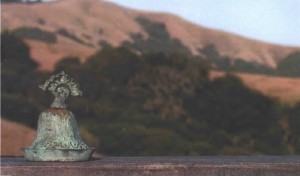
Photo by David Simoni
From Mandala June-August 2002, San Francisco writer Steven Moss shares the story of how silence can sometimes allow for long-overdue communication:
“I haven’t spoken to her in twenty-two years, and I don’t intend to start now,” my mother proclaimed, scrubbing at the already clean counter to emphasize her point.
“But Mom, it’s a silent retreat. You won’t be talking to her. In fact, you’ll be encouraged not to,” I said to the back of her head. I noticed her hair was still mostly black, with only a few specks of grey.
“Yes, well, as long as she doesn’t try to talk to me. I’m not having any of that.”
I’d made the mistake of telling my mother about a retreat I was going on with Aunt Gen. Knowing of my budding interest in Buddhism, Gen had found a course for me to take at Spirit Rock, a local meditation center. She offered to pay the fee, and, after we talked about it, asked if she could come along. I was delighted to spend time with my aunt, who’d taken up Spanish at 60, and tap dance lessons at 65.
After I told my mother, she insisted on joining us. Not because of any interest in Buddhism, but to make sure her older sister didn’t spend any more time with me then she did. Still, she wanted to make it clear that while she was going to the retreat, she would not be speaking to my aunt. …
13
His Holiness the Sakya Trizin Speaks on Guru Devotion
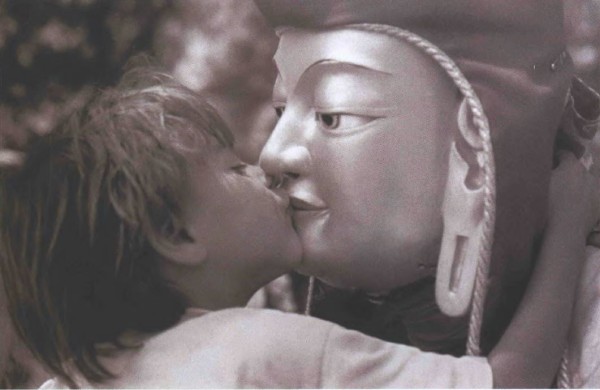
Photo by Peg Michie
His Holiness the Sakya Trizin had some surprising answers to Julia Hengst’s questions about devotion to one’s teacher. She traveled to Pullawari, India to meet with him in February.
Julia: You commented in the March 2000 issue of Mandala that in the Vajrayana tradition the guru is seen as the Buddha, whereas in the Mahayana tradition the guru is seen as being like the Buddha, not that he is the Buddha. Can you expand on this so that students can understand the difference?
His Holiness: In every school, Hinayana, Mahayana and Vajrayana, the guru is very important. Even in an ordinary sense, without a teacher you can’t learn things. Every level in each of the schools emphasizes how important the master is. But in the lower vehicles, Hinayana and especially in the Mahayana, although the teacher is very important, the teacher is not the Buddha. He is as important as Buddha, but not a real Buddha.
But in Vajrayana, in order to realize the nature of the mind, you need the blessings of the guru and accumulations of the merits. Without these, you cannot realize the nature of the mind, even through studies, logic, reasoning or examples. You can get an idea about it, but you can’t realize it without the guru’s blessings. For example, the sun is shining everyday, all the time. But without specific instruments, you can’t use the energy of the sun. Like that, the Buddha’s blessings are shining all over sentient beings all the time without any interruption …
Read the complete article as a PDF from Mandala June-August 2002.
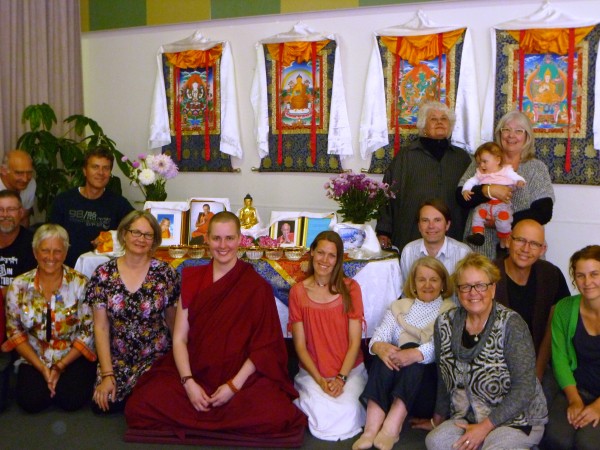
Ven. Lozang Yonten and Chag-tong Chen-tong students at the beginning of the year, Tasmania, Australia, January 2013. Photo courtesy of Chag-tong Chen-tong Centre.
Ven. Lindy Mailhot, director of Chag-Tong Chen-Tong Centre (CTCT) in Snug, Tasmania, Australia, shared with Mandala a quick message about the center’s 2013 program.
CTCT has enjoyed a wonderful beginning to our 2013 program with visiting teachers bringing great benefit, inspiration, support and friendship to our community.
Ven. Lozang Yonten, currently resident teacher at Kusang Yeshe Retreat Centre in the Blue Mountains of New South Wales, introduced the New Year with a wonderful weekend on “New Year Resolutions from a Dharma Perspective” based around the seven-point mind training teachings.
Glen Svensson joined us during February, leading two weekend retreats on shamata and the Gelug tradition of Mahamudra. And Thubten Yeshe (T.Y.) returned to lead our annual Easter four-day lam-rim retreat.
One new students shared thoughts on the retreat experiences that have grown over the last two years:
I know that a lot of people find it hard to make the time in their busy lives for retreat; it just seems too daunting! Our commitments to work and family seem to make retreat too difficult to organize … but it’s a challenge that’s well worth the effort.
I never knew what the rewards and benefits were until I recently did my first three-day retreat. I had believed that just attending the day sessions would suffice, but attending a retreat is of much deeper benefit.
Retreat is a time to come face-to-face with who you are and to see yourself clearly for the first time. The benefits are profound, felt not just by ourselves, but also by everyone we come into contact with.
In retreat we can develop the basic qualities of affection and loving kindness, and the teachings help us to learn to put that into practice. Yet even when we return from the retreat to “everyday life,” the values remain strong and the principles stay true.
From each retreat I attend, I know myself a little better and find the teachings resonate with me longer. One of my heartfelt wishes is that everyone can experience a retreat.
It is a special time with like-minded friends living, practicing, meditating, eating together minus the distraction of family/work life, just for a short time.
With our wish to be able to offer regular opportunities of retreat experience, by building this more and more into our program over the last two years we are finding that the students and friends of CTCT are slowly becoming familiar with the methods of integrating study and practice and are enjoying the vast and subtle benefits. Much to our delight, we are starting to hear people talk of their longing to do retreat, even if its just one day.
Ven. Robina Courtin recently visited Chag-Tong Chen-Tong Centre June 4-9 and lead a three-day residential retreat “How to Practice Dharma – Teachings on the Eight Worldy Dharmas.” The center writes that they look forward to Ven. Antonio Satta visitng in August to lead a ten-day vipassana retreat.
- Tagged: chag-tong chen-tong, mandala, retreat, ven. lindy mailhot
- 0
7

Bill Wilson shares his story on V-Voice Blog (blog.vajrapani.org). Photo courtesy of Vajrapani Institute.
Student and assistant warden in the California prison system Bill Wilson shares on FPMT retreat center Vajrapani Institute’s V-Voice Blog the story of how a mentor profoundly changed his life, an experience that coincidentally brought him to the Dharma:
“I believed I was a good man, and tried to help others as best I could, but as I watched Dave interact with inmates I realized I was only partly fulfilling my duties as a law enforcement official and a member of my community. He wasn’t just professional and courteous, he tried to make a positive imprint on every inmate (and staff member) he had contact with. It didn’t matter the crime they committed, the color of their skin, their gang affiliation or their intellect, he reached out with loving kindness, compassion and empathy to men who were commonly marginalized. Yes, we fed and clothed them, and at times tried to provide them with inspiration, but until I watched Dave in action, I didn’t know we usually ignored the most crucial truth: that the inmates continued to be human beings.
“… My journey with Dave and our men opened another door, perhaps the most important … I met volunteer Jon Landaw, who introduced me to Ven. Tenzin Chogkyi. As we talked about our men, I mentioned that I was amazed by the incredible changes I had witnessed and how I hoped to be able to make similar changes in my own life. The next thing I knew I was at the Vajrapani Institute experiencing my first formal meditation training ‘Mindfulness and Reality: Introduction to Meditation’ …”
Located in the redwood forests of the Santa Cruz Mountains in Northern California, Vajrapani Institute offers meditation retreat cabins, Tibetan Buddhist group courses and retreats, and facility rentals for spiritual groups of all traditions.
If you like what you read on Mandala, consider becoming a Friend of FPMT, which supports our work. Friends of FPMT at the Basic level and higher receive the print magazine Mandala, delivered quarterly to their homes.
- Tagged: bill wilson, mandala, prisoners, vajrapani institute
- 0
6
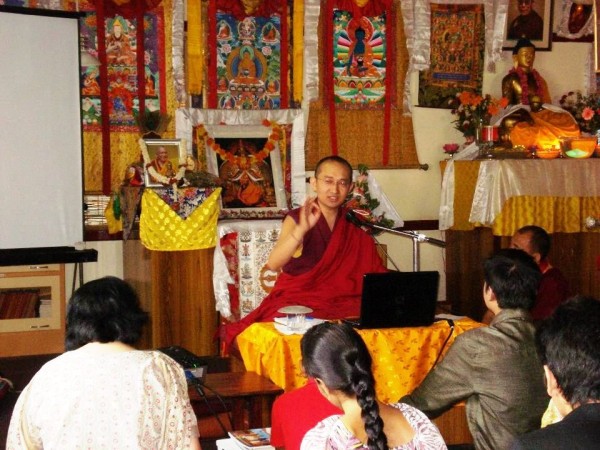
Khangser Rinpoche teaches at Choe Khor Sum Ling, Bangalore, India, April 2013. Photo by Anupama Saraf.
FPMT study group Choe Khor Sum Ling in Bangalore is an active community in South India, founded at the request of His Holiness the Dalai Lama by Lama Zopa Rinpoche to “offer this cultural treasure [Buddhadharma] back to the people of the land of its origin.” Shanti Gopinath, center member, updates Mandala on the group’s latest news:
“April 2013 was an action-packed month at Choe Khor Sum Ling. We were extremely honored when Khangser Rinpoche, one of the great lharampa geshes, adorned with boundless compassion and endowed with convincing speech in accordance with the modern world view, accepted our request to teach. On April 21, Rinpoche gave a talk on ‘Nothing Exists Inherently, Yet Everything Exists Dependently.’ Khangser Rinpoche, in his unique, humorous and fluid style, taught us how our destiny is in our own hands. The interactive session gave us a deep-level understanding of overcoming our afflictions and finding lasting happiness in the toughest of situations. The teaching was followed by a Vajrasattva initiation on April 22. Not only did Rinpoche take us through the ritual, but also explained the ceremonial prayers and meditations that were involved.
“Our precious Sera Je teacher, Ven. Gyalten Rabten, conducted Guru Puja and the second session of Buddhist Meditation 101 on April 27-28.
“As a center we’ve also introduced three brand new weekend courses: FPMT Education Services’ Discovering Buddhism (We wish to thank them for the precious opportunity, their guidance and tremendous support.); a course on Nagarjuna’s Letter to a Friend composed by Arya Nagarjuna for King Gautamiputra; and Mind Training in the Great Way, designed around the Wheel of Sharp Weapons. Our adept teachers – Vens. Tenzin Namdak, Tenzin Legtsok and Tenzin Namjong – engaged in geshe studies at Sera Je Monastic University, will be leading the new courses.”
In February, Choe Khor Sum Ling had the honor of hosting Tenzin Ösel Hita. His videoed talk, “How to Understand Our Reality from the Universal Point of View,” is available on fpmt.org/mandala/.
Discover Choe Khor Sum Ling’s YouTube channel and find more talks from visiting teachers, including Khangser Rinpoche and Ven. Thubten Chodron.
If you like what you read on Mandala, consider becoming a Friend of FPMT, which supports our work. Friends of FPMT at the Basic level and higher receive the print magazine Mandala, delivered quarterly to their homes.
- Tagged: choe khor sum ling, khangser rinpoche, mandala
- 0
5
Lama Zopa Rinpoche Answers Questions about Reincarnation and Karma
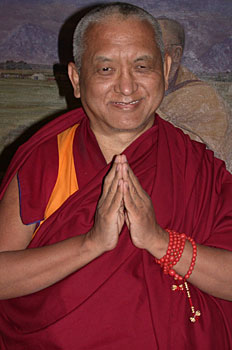
Lama Zopa Rinpoche, Buddha Amitabha Pure Land, Washington State, USA, November 2003. Photo courtesy of fpmt.org.
“Do we have to believe in reincarnation to attain enlightenment?” a student asked Lama Zopa Rinpoche during the Fifth Kopan Meditation Course, November 1973.
“Forget about belief,” Rinpoche responded. “It’s impossible to attain enlightenment without realizing the fact of reincarnation, or rebirth.
“In the East, in the West, black, white, yellow, in whatever kind of body we find ourselves, most of us were born without choice, without freedom. There’s a reason that we have to experience rebirth without choice, a life without freedom. First of all, this lack of control of our rebirth itself is what the Buddha meant by suffering. Similarly, death without control is also suffering. In addition, the suffering of uncontrolled rebirth and death has a cause, and the cause was created before this life began. The result – uncontrolled suffering rebirth and death – and their principal cause can’t be born together any more than a mother and her child can be born together….”
Continue reading Rinpoche’s answers to other probing questions about karma and reincarnation in “Ask a Lama with Lama Zopa Rinpoche” from Mandala September-November 2003.
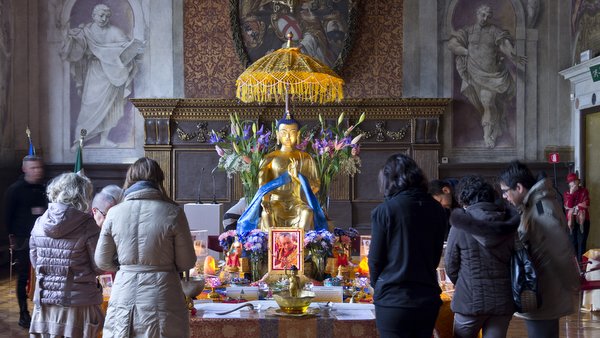
The Maitreya Heart Shrine Relic Tour visits Palazzo della Gran Guardia in downtown Padova, Italy, February 2013. Photo by Flavio Zanchetta.
In February 2013, Centro Tara Cittamani in Padova (Padua), Italy celebrated its 20th anniversary.
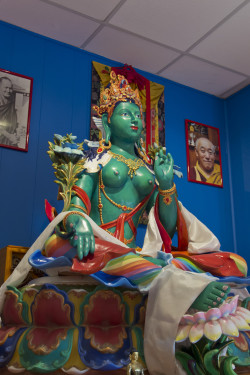
Green Tara statue by Alfredo Baracco at Centro Tara Cittamani, Padova, Italy, February 2013. Photo by Flavio Zanchetta.
After being established in 1993, the center spent years looking for a more permanent residence. “At that time, the activities were mainly carried out in rented halls or gyms, organized by a small but very active group of volunteers whose motivation was to raise awareness of Dharma and benefit the greatest possible number of people,” shared Paolo De Luise, center board member. It wasn’t until 2004 when Centro Tara Cittamani found its home in the suburbs of Padova.
Inaugurated by Lama Zopa Rinpoche, the late Geshe Jampa Gyatso and Geshe Tenzin Tenphel, the new center has a gompa that seats 60 and features a Green Tara statue by Alfredo Baracco. The center shares its other rooms with Motus Mundi, an association that promotes mindfulness to adults and children through secular activities such as yoga, tai chi, Pilates and English classes.
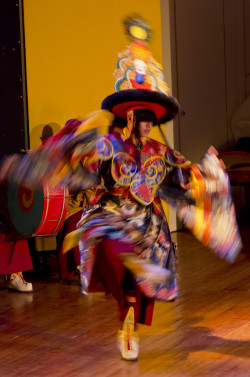
Sera Je monks performed ritual dances as part of Centro Tara Cittamani’s 20th anniversary celebration, Padova, Italy, February 2013. Photo by Flavio Zanchetta.
“To celebrate our 20th anniversary,” continued Paolo, “in February the center hosted in a city theater, with an audience of more than 400 people, the Tour of Compassion and Harmony organized by the monks of Sera Je Monastery, who performed the sacred ritual dances and who made a beautiful mandala of the Medicine Buddha in our gompa. Moreover, in April in the prestigious Palazzo della Gran Guardia located in the city center, thanks to the patronage of the Municipality of Padova, more than 1,200 people benefited for a whole weekend from the positive energy of the Buddha’s relics [from the Maitreya Heart Shrine Relic Tour].”
Centro Tara Cittamani is part of the Unione Buddhista Italiana (Italian Buddhist Union), which in February was officially recognized by the Italian government as a “religious confession,” an honor only held by one other non-Judeo-Christian tradition. The center hopes in the coming years to host a resident geshe.
If you like what you read on Mandala, consider becoming a Friend of FPMT, which supports our work. Friends of FPMT at the Basic level and higher receive the print magazine Mandala, delivered quarterly to their homes.
- Tagged: anniversary, centro tara cittamani, mandala, paolo de luise
- 0
- Home
- News/Media
- Study & Practice
- About FPMT Education Services
- Latest News
- Programs
- New to Buddhism?
- Buddhist Mind Science: Activating Your Potential
- Heart Advice for Death and Dying
- Discovering Buddhism
- Living in the Path
- Exploring Buddhism
- FPMT Basic Program
- FPMT Masters Program
- FPMT In-Depth Meditation Training
- Maitripa College
- Lotsawa Rinchen Zangpo Translator Program
- Universal Education for Compassion & Wisdom
- Online Learning Center
- Prayers & Practice Materials
- Overview of Prayers & Practices
- Full Catalogue of Prayers & Practice Materials
- Explore Popular Topics
- Benefiting Animals
- Chenrezig Resources
- Death & Dying Resources
- Lama Chopa (Guru Puja)
- Lama Zopa Rinpoche: Compendium of Precious Instructions
- Lama Zopa Rinpoche: Life Practice Advice
- Lama Zopa Rinpoche Practice Series
- Lamrim Resources
- Mantras
- Prayer Book Updates
- Purification Practices
- Sutras
- Thought Transformation (Lojong)
- Audio Materials
- Dharma Dates – Tibetan Calendar
- Translation Services
- Publishing Services
- Teachings and Advice
- Find Teachings and Advice
- Lama Zopa Rinpoche Advice Page
- Lama Zopa Rinpoche: Compendium of Precious Instructions
- Lama Zopa Rinpoche Video Teachings
- ༧སྐྱབས་རྗེ་བཟོད་པ་རིན་པོ་ཆེ་མཆོག་ནས་སྩལ་བའི་བཀའ་སློབ་བརྙན་འཕྲིན།
- Podcasts
- Lama Yeshe Wisdom Archive
- Buddhism FAQ
- Dharma for Young People
- Resources on Holy Objects
- Ways to Offer Support
- Centers
- Affiliates Area
- Teachers
- Projects
- Charitable Projects
- Make a Donation
- Applying for Grants
- News about Projects
- Other Projects within FPMT
- Support International Office
- Projects Photo Galleries
- Give Where Most Needed
- FPMT
- Shop
Subscribe to FPMT News
Translate*
*powered by Google TranslateTranslation of pages on fpmt.org is performed by Google Translate, a third party service which FPMT has no control over. The service provides automated computer translations that are only an approximation of the websites' original content. The translations should not be considered exact and only used as a rough guide.Like molding dough in your hand, you can definitely turn your mind whichever way you want.







